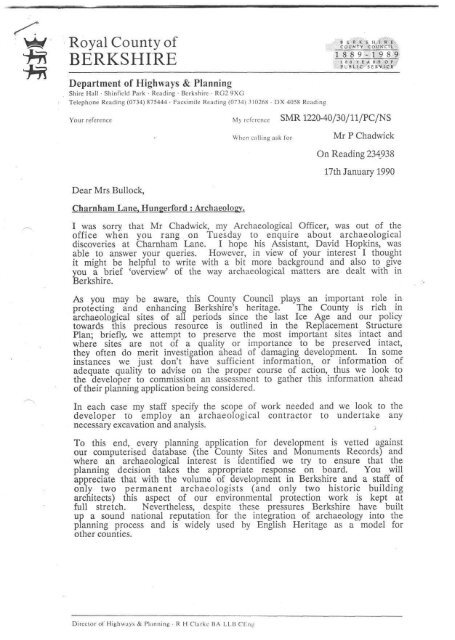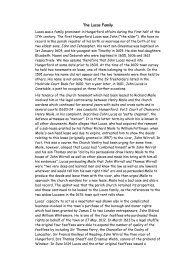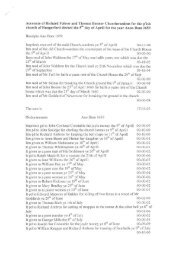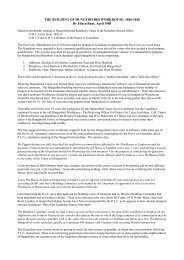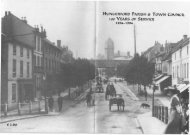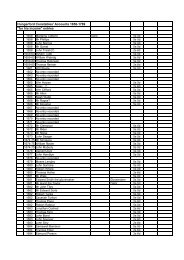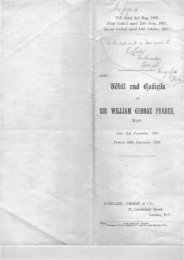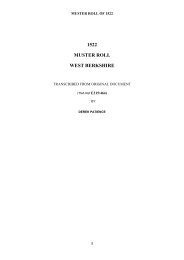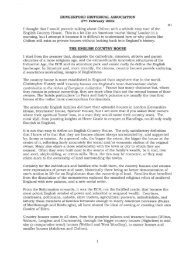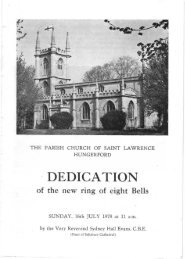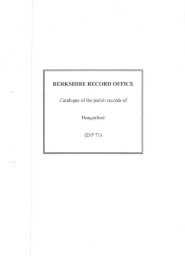Letter from Berkshire CC to Hungerford Mayor summarising the dig
Letter from Berkshire CC to Hungerford Mayor summarising the dig
Letter from Berkshire CC to Hungerford Mayor summarising the dig
You also want an ePaper? Increase the reach of your titles
YUMPU automatically turns print PDFs into web optimized ePapers that Google loves.
Royal County of<br />
BERKSHIRE<br />
Department of Highways & Planning<br />
Shire Hall • Shinfield Park • Reading • <strong>Berkshire</strong> • RG2 9XG<br />
Telephone Reading (0734) 875444 • Facsimile Reading (0734) 310268 • DX 4058 Reading<br />
8 E R .K S H :T R E<br />
C 0 UN V V.*' : G CtIJK'Ctt ;: i<br />
Your reference My reference SMR 1220-40/30/1 1/PC/NS<br />
When calling ask for<br />
Mr P Giadwick<br />
Dear Mrs Bullock,<br />
Charnham Lane. <strong>Hungerford</strong> ; Archaeology.<br />
On Reading 234938<br />
17th January 1990<br />
I was sorry that Mr Chadwick, my Archaeological Officer, was out of <strong>the</strong><br />
office when you rang on Tuesday <strong>to</strong> enquire about archaeological<br />
discoveries at Charnham Lane. I hope his Assistant, David Hopkins, was<br />
able <strong>to</strong> answer your queries. However, in view of your interest I thought<br />
it might be helpful <strong>to</strong> write with a bit more background and also <strong>to</strong> give<br />
you a brief 'overview' of <strong>the</strong> way archaeological matters are dealt with in<br />
<strong>Berkshire</strong>.<br />
As you may be aware, this County Council plays an important role in<br />
protecting and enhancing <strong>Berkshire</strong>'s heritage. The County is rich in<br />
archaeological sites of all periods since <strong>the</strong> last Ice Age and our policy<br />
<strong>to</strong>wards this precious resource is outlined in <strong>the</strong> Replacement Structure<br />
Plan; briefly, we attempt <strong>to</strong> preserve <strong>the</strong> most important sites intact and<br />
where sites are not of a quality or importance <strong>to</strong> be preserved intact,<br />
<strong>the</strong>y often do merit investigation ahead of damaging development. In some<br />
instances we just don't have sufficient information, or information of<br />
adequate quality <strong>to</strong> advise on <strong>the</strong> proper course of action, thus we look <strong>to</strong><br />
<strong>the</strong> developer <strong>to</strong> commission an assessment <strong>to</strong> ga<strong>the</strong>r this information ahead<br />
of <strong>the</strong>ir planning application being considered.<br />
In each case my staff specify <strong>the</strong> scope of work needed and we look <strong>to</strong> <strong>the</strong><br />
developer <strong>to</strong> employ an archaeological contrac<strong>to</strong>r <strong>to</strong> undertake any<br />
necessary excavation and analysis. .<br />
To this end, every planning application for development is vetted against<br />
our computerised database (<strong>the</strong> County Sites and Monuments Records) and<br />
where an archaeological interest is identified we try <strong>to</strong> ensure that <strong>the</strong><br />
planning decision takes <strong>the</strong> appropriate response on board. You will<br />
appreciate that with <strong>the</strong> volume of development in <strong>Berkshire</strong> and a staff of<br />
only two permanent archaeologists (and only two his<strong>to</strong>ric building<br />
architects) this aspect of our environmental protection work is kept at<br />
full stretch. Never<strong>the</strong>less, despite <strong>the</strong>se pressures <strong>Berkshire</strong> have built<br />
up a sound national reputation for <strong>the</strong> integration of archaeology in<strong>to</strong> <strong>the</strong><br />
planning process and is widely used by English Heritage as a model for<br />
o<strong>the</strong>r counties.<br />
Direc<strong>to</strong>r of Highways & Planning • R H Clarke BA LLB CEng
In <strong>the</strong> case of Charnham Lane <strong>the</strong> planning applications for development are<br />
being handled by Newbury District Council. However, in line with <strong>the</strong><br />
procedures set out above, <strong>the</strong> Heritage Group checked <strong>the</strong> applications and<br />
considered whe<strong>the</strong>r <strong>the</strong>re was an archaeological interest. Although we had<br />
no direct evidence <strong>from</strong> <strong>the</strong> site, it was evident that <strong>the</strong> site had high<br />
potential, and that any evidence that existed would be destroyed if an<br />
investigation did not precede development. Accordingly, we asked <strong>the</strong><br />
developer <strong>to</strong> commission an archaeological assessment of <strong>the</strong> site. This he<br />
did, and <strong>the</strong> trial, trenches excavated by Thames Valley Archaeological<br />
Services <strong>to</strong> a specification set by <strong>the</strong> Heritage Group located evidence<br />
indicating that <strong>the</strong> Charnham Lane area was first settled around 10,000<br />
BC! Although remains <strong>from</strong> this remote period were pretty sparce, evidence<br />
of structures and buildings belonging <strong>to</strong> <strong>the</strong> early Bronze Age (15,00 BC)<br />
and <strong>the</strong> medieval period (1100 - 1500AD) have been located.<br />
Work examining <strong>the</strong>se sites in more detail is drawing <strong>to</strong> a close, <strong>the</strong>n <strong>the</strong><br />
excava<strong>to</strong>rs return <strong>to</strong> <strong>the</strong>ir base <strong>to</strong> sort out <strong>the</strong> 'pieces of jigsaw' and<br />
decipher <strong>the</strong> picture that emerges. We are particularly lucky at Charnham<br />
Lane that <strong>the</strong> peat deposits near <strong>the</strong> river have provided evidence about<br />
past environments. Thus, in time, we should be able <strong>to</strong> reconstruct not<br />
only where and when people settled and farmed <strong>the</strong>re, but also what <strong>the</strong><br />
landscape looked like in prehis<strong>to</strong>ric and later times.<br />
All this work had been funded by <strong>the</strong> developer and has been supervised and<br />
moni<strong>to</strong>red by staff <strong>from</strong> <strong>the</strong> Heritage Group. We are certainly very pleased<br />
with <strong>the</strong> discoveries and hope <strong>the</strong> enclosed information sheds some light on<br />
<strong>the</strong> site.<br />
If you would like any more information about <strong>the</strong> Charnham Lane site, or<br />
o<strong>the</strong>rs in your neighbourhood, please do not hesitate <strong>to</strong> contact me.<br />
You/s^incerely,<br />
A<br />
Mrs G Bullock<br />
104 High Street<br />
<strong>Hungerford</strong><br />
Berks<br />
RG19 ONB


